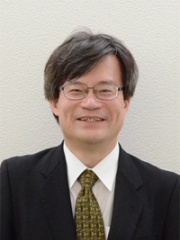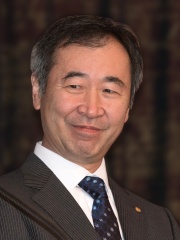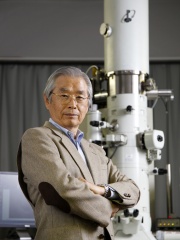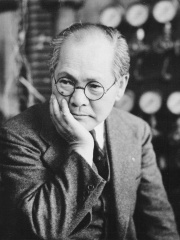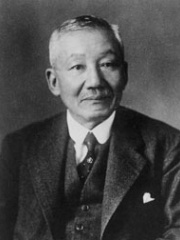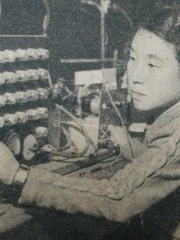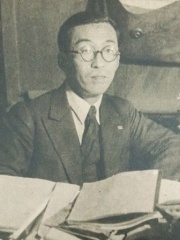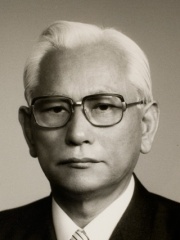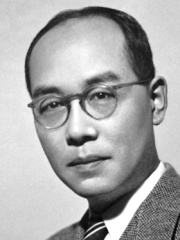

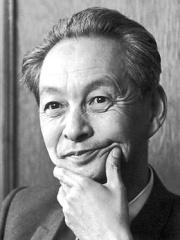
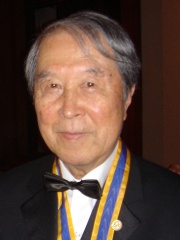
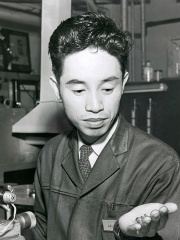
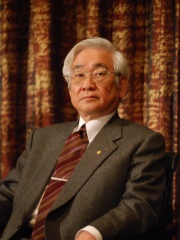
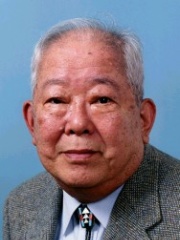
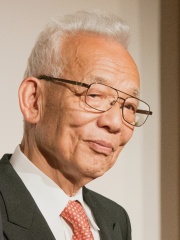
The Most Famous
PHYSICISTS from Japan
This page contains a list of the greatest Japanese Physicists. The pantheon dataset contains 851 Physicists, 20 of which were born in Japan. This makes Japan the birth place of the 9th most number of Physicists behind Netherlands, and Austria.
Top 10
The following people are considered by Pantheon to be the top 10 most legendary Japanese Physicists of all time. This list of famous Japanese Physicists is sorted by HPI (Historical Popularity Index), a metric that aggregates information on a biography's online popularity. Visit the rankings page to view the entire list of Japanese Physicists.

1. Hideki Yukawa (1907 - 1981)
With an HPI of 73.06, Hideki Yukawa is the most famous Japanese Physicist. His biography has been translated into 86 different languages on wikipedia.
Hideki Yukawa (Japanese: 湯川 秀樹; né Ogawa; 23 January 1907 – 8 September 1981) was a Japanese theoretical physicist who received the Nobel Prize in Physics in 1949 "for his prediction of the existence of mesons on the basis of theoretical work on nuclear forces."

2. Isamu Akasaki (1929 - 2021)
With an HPI of 72.34, Isamu Akasaki is the 2nd most famous Japanese Physicist. His biography has been translated into 70 different languages.
Isamu Akasaki (Japanese: 赤﨑 勇, romanized: Akasaki Isamu; January 30, 1929 – April 1, 2021) was a Japanese electronic engineer specializing in the field of semiconductor technology. He is best known for co-inventing the bright gallium nitride (GaN) p–n junction blue LED in 1989 and subsequently the high-brightness GaN blue LED as well. Akasaki was awarded the 2014 Nobel Prize in Physics, together with Hiroshi Amano and Shuji Nakamura, "for the invention of efficient blue light-emitting diodes, which has enabled bright and energy-saving white light sources."

3. Shin'ichirō Tomonaga (1906 - 1979)
With an HPI of 72.31, Shin'ichirō Tomonaga is the 3rd most famous Japanese Physicist. His biography has been translated into 74 different languages.
Shinichiro Tomonaga (朝永 振一郎, Tomonaga Shin'ichirō; March 31, 1906 – July 8, 1979), usually cited as Sin-Itiro Tomonaga in English, was a Japanese physicist, influential in the development of quantum electrodynamics, work for which he was jointly awarded the Nobel Prize in Physics in 1965 along with Richard Feynman and Julian Schwinger.

4. Yoichiro Nambu (1921 - 2015)
With an HPI of 71.40, Yoichiro Nambu is the 4th most famous Japanese Physicist. His biography has been translated into 68 different languages.
Yoichiro Nambu (南部 陽一郎, Nanbu Yōichirō; 18 January 1921 – 5 July 2015) was a Japanese-American physicist and professor at the University of Chicago. Known for his groundbreaking contributions to theoretical physics, Nambu was the originator of the theory of spontaneous symmetry breaking, a concept that revolutionized particle physics. He was also a pioneer of quantum chromodynamics (QCD), one of the founding figures of string theory, and the proposer of Nambu mechanics. In addition, he co-created the Nambu–Jona-Lasinio model, which explained the dynamical origin of mass in nucleons. He was awarded half of the Nobel Prize in Physics in 2008 for the discovery in 1960 of the mechanism of spontaneous broken symmetry in subatomic physics, related at first to the strong interaction's chiral symmetry and later to the electroweak interaction and Higgs mechanism. The other half was split equally between Makoto Kobayashi and Toshihide Maskawa "for the discovery of the origin of the broken symmetry which predicts the existence of at least three families of quarks in nature".
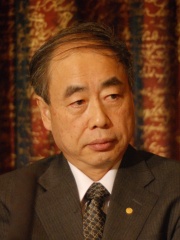
5. Makoto Kobayashi (b. 1944)
With an HPI of 70.90, Makoto Kobayashi is the 5th most famous Japanese Physicist. His biography has been translated into 62 different languages.
Makoto Kobayashi (小林 誠, Kobayashi Makoto; born April 7, 1944) is a Japanese physicist known for his work on CP-violation who was awarded one-fourth of the 2008 Nobel Prize in Physics "for the discovery of the origin of the broken symmetry which predicts the existence of at least three families of quarks in nature."

6. Leo Esaki (b. 1925)
With an HPI of 70.47, Leo Esaki is the 6th most famous Japanese Physicist. His biography has been translated into 73 different languages.
Leo Esaki ( ih-SAH-kee; Japanese: 江崎 玲於奈, romanized: Esaki Reona; born March 12, 1925) is a Japanese solid-state physicist who shared the 1973 Nobel Prize in Physics with Ivar Giaever and Brian Josephson for his work on tunneling in semiconductors, which led to his invention of the tunnel diode that exploits this phenomenon. His research was done when he was with Sony. He has also contributed in being a pioneer of semiconductor superlattices.

7. Toshihide Maskawa (1940 - 2021)
With an HPI of 69.39, Toshihide Maskawa is the 7th most famous Japanese Physicist. His biography has been translated into 63 different languages.
Toshihide Maskawa (or Masukawa) (益川 敏英, Masukawa Toshihide; 7 February 1940 – 23 July 2021) was a Japanese theoretical physicist known for his work on CP-violation who was awarded one quarter of the 2008 Nobel Prize in Physics "for the discovery of the origin of the broken symmetry which predicts the existence of at least three families of quarks in nature."

8. Masatoshi Koshiba (1926 - 2020)
With an HPI of 68.84, Masatoshi Koshiba is the 8th most famous Japanese Physicist. His biography has been translated into 72 different languages.
Masatoshi Koshiba (小柴 昌俊, Koshiba Masatoshi; 19 September 1926 – 12 November 2020) was a Japanese physicist and one of the founders of neutrino astronomy. His work with the neutrino detectors Kamiokande and Super-Kamiokande was instrumental in detecting solar neutrinos, providing experimental evidence for the solar neutrino problem. Koshiba won the Nobel Prize in Physics in 2002, jointly with Raymond Davis Jr., "for pioneering contributions to astrophysics, in particular for the detection of cosmic neutrinos". Koshiba was the first Japanese Nobel laureate to hold two doctoral degrees. In addition, he was the second Japanese recipient of both the Nobel Prize and the Wolf Prize. His mentor, Sin-Itiro Tomonaga, and his student, Takaaki Kajita, were also Nobel Prize winners in Physics. He was a senior counselor at the International Center for Elementary Particle Physics (ICEPP) and professor at the University of Tokyo.

9. Syukuro Manabe (b. 1931)
With an HPI of 68.21, Syukuro Manabe is the 9th most famous Japanese Physicist. His biography has been translated into 47 different languages.
Syukuro "Suki" Manabe (真鍋 淑郎, Manabe Shukurō; born 21 September 1931) is a Japanese–American physicist, meteorologist, and climatologist, who pioneered the use of computers to simulate global climate change and natural climate variations. He was awarded the 2021 Nobel Prize in Physics jointly with Klaus Hasselmann and Giorgio Parisi, for his contributions to the physical modeling of Earth's climate, quantifying its variability, and predictions of climate change.
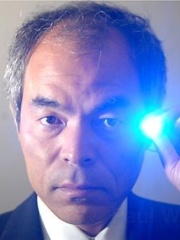
10. Shuji Nakamura (b. 1954)
With an HPI of 66.98, Shuji Nakamura is the 10th most famous Japanese Physicist. His biography has been translated into 68 different languages.
Shuji Nakamura (Japanese: 中村 修二, romanized: Nakamura Shūji; born May 22, 1954) is a Japanese–American electronic engineer and co-inventor of the blue LED, a major breakthrough in lighting technology. He specializes in the field of semiconductor technology. He is Professor of Materials and of Electrical and Computer Engineering at the University of California, Santa Barbara (UCSB) since 1999. Together with Isamu Akasaki and Hiroshi Amano, Nakamura received the 2014 Nobel Prize in Physics "for the invention of efficient blue light-emitting diodes, which has enabled bright and energy-saving white light sources."
People
Pantheon has 20 people classified as Japanese physicists born between 1865 and 1960. Of these 20, 7 (35.00%) of them are still alive today. The most famous living Japanese physicists include Makoto Kobayashi, Leo Esaki, and Syukuro Manabe. The most famous deceased Japanese physicists include Hideki Yukawa, Isamu Akasaki, and Shin'ichirō Tomonaga.
Living Japanese Physicists
Go to all RankingsMakoto Kobayashi
1944 - Present
HPI: 70.90
Leo Esaki
1925 - Present
HPI: 70.47
Syukuro Manabe
1931 - Present
HPI: 68.21
Shuji Nakamura
1954 - Present
HPI: 66.98
Hiroshi Amano
1960 - Present
HPI: 63.92
Takaaki Kajita
1959 - Present
HPI: 63.54
Sumio Iijima
1939 - Present
HPI: 57.75
Deceased Japanese Physicists
Go to all RankingsHideki Yukawa
1907 - 1981
HPI: 73.06
Isamu Akasaki
1929 - 2021
HPI: 72.34
Shin'ichirō Tomonaga
1906 - 1979
HPI: 72.31
Yoichiro Nambu
1921 - 2015
HPI: 71.40
Toshihide Maskawa
1940 - 2021
HPI: 69.39
Masatoshi Koshiba
1926 - 2020
HPI: 68.84
Yoshio Nishina
1890 - 1951
HPI: 63.36
Hantaro Nagaoka
1865 - 1950
HPI: 62.47
Toshiko Yuasa
1909 - 1980
HPI: 60.46
Shoichi Sakata
1911 - 1970
HPI: 57.43
Yoshiaki Arata
1924 - 2018
HPI: 55.87
Kazuhiko Nishijima
1926 - 2009
HPI: 55.76
Overlapping Lives
Which Physicists were alive at the same time? This visualization shows the lifespans of the 10 most globally memorable Physicists since 1700.

